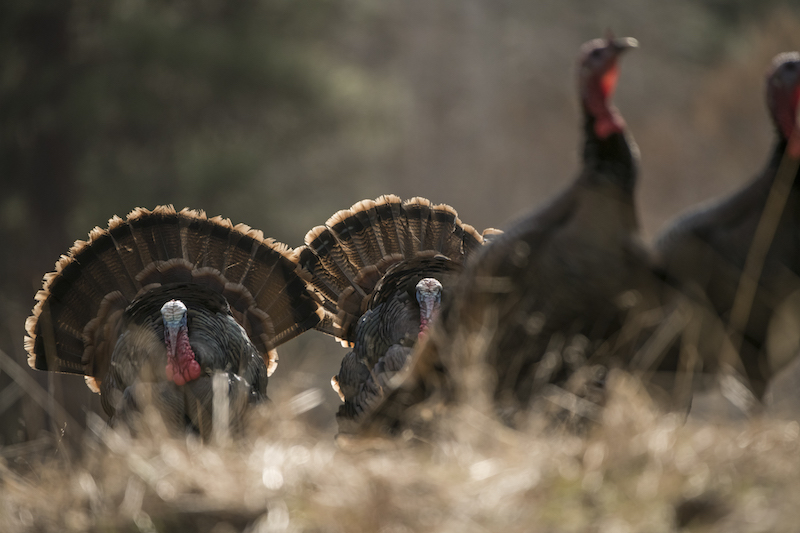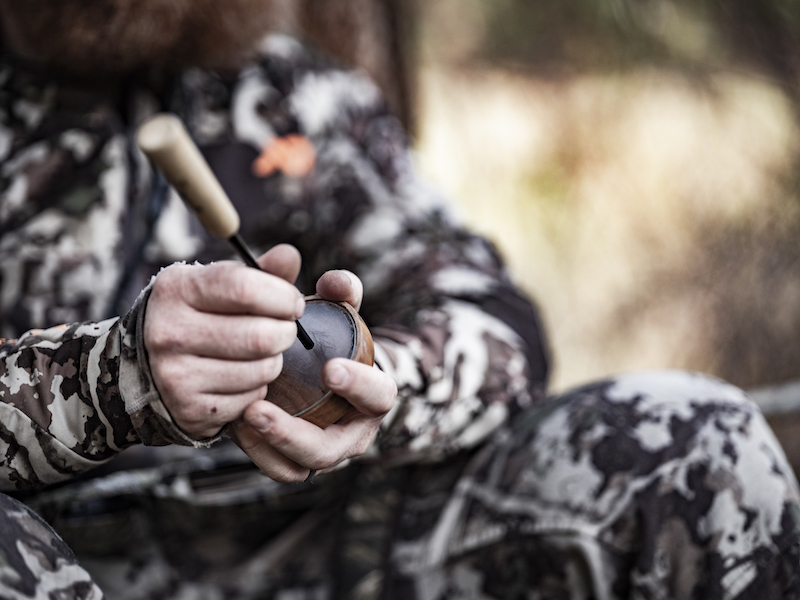Your excitement peaks as you scout your favorite turkey-hunting hotspot from afar as opening day nears. You’re more confident than ever as you glass a flock with multiple toms and a harem of hens. You’re tempted to guarantee success, right?
But much like whitetails nearing the rut, a wild turkey’s behavior changes drastically during spring’s breeding season. Areas that held lots of birds early in the season can quickly go dormant. To foil fickle gobblers and fill your tag, you must constantly adapt your strategies.

Turkeys will feed in large groups during the pre-strut season. Photo Credit: John Hafner
Turkey hunting in late March through mid-April varies wildly. Opening day falls into this timeframe for many states, and you’ll often find turkeys feeding in large groups of hens and gobblers. Toms gobble from their roosts, but often go quiet after fly-down. With green-up weeks away, turkeys focus on picked crop fields or riverbottoms to feed and dust.
Turkeys are easily patterned during the early season, so scouting is critical. Leading up to your hunt, listen for predawn gobbles to identify roosting areas. Watch these sites from a distance, and note where the gobblers head once they pitch down. Identify landmarks where turkeys spend most of their time. Deploy a pop-up blind or build a natural one in those sites, and wait them out. Rather than calling aggressively, place one hen decoy and occasionally make slow, passive yelps to imitate a lonely hen straying from the flock. If the strategy works, a frustrated tom might strut into range to corral your “lonely” decoy.

Much like deer, turkeys exhibit erratic behavior during the strut season and should be hunted on foot. Photo credit: ATA
Hunting heats up in late April and early May as the woods green up and hens use thick cover to nest. When that happens, lonely toms might gobble all day, giving hunters opportunities to work gobblers at any time. By this time in the season, turkeys aren’t as easily patterned as they were weeks before. Their movements and behaviors seem erratic, but toms are moving and the weather is improving, so you can’t find a better time to be afield.
Unlike the early season when you could ambush turkeys from one site, midseason calls for mobile and aggressive tactics. Toms aren’t predictable, so don’t commit to one area. If birds go quiet at your first spot, cover ground and try to intercept a tom elsewhere. Walk ridgetops and stop occasionally to call until striking a gobble. It’s an effective way to explore new areas while increasing your odds of finding a hot gobbler. After triggering a response, close the distance as much as possible and stake a jake-and-hen decoy combo. Toms can quickly get agitated, and charge in to flog the jake, giving you time to shoot.

Even after strut season is over, the turkeys will still respond to calls. Photo Credit: John Hafner
Late May means pressured turkeys, lots of bugs and warm weather. That might not sound ideal for hunting, but toms can still fall for aggressive calling and decoy tactics when the woods are lush and green. Most hens spend midday in their nesting areas, and toms troll field edges and fencelines for late-season mates. Hot weather can also drive strutters from fields, pushing them into shady areas in mature timber to stay cool. In other words, heat makes the toms’ whereabouts relatively predictable.
Late season is a good time to get creative. After all, hunters have been educating toms throughout the season. Switching up your calling cadence and adding realism to your setup by scratching leaves to mimic feeding turkeys can subtly distinguish you from other hunters. Consider using aggressive decoys, such as full or ¾-strut toms, to incite a tom’s wrath. Realize, though, that you might spook subordinate toms with that tactic.
Turkey behavior is always changing, so you must adapt to succeed. By spending more time hunting and evaluating your tactics case by case, you’ll modify these tips to create your own plans for success.